




Why Is Skin Important for Our Body?
Which is the largest organ in your body? If you’ve guessed it to be the liver, you are partially right. But this largest organ we are referring to right now has a surface area of about around 2m2 and is probably the largest surface area in our body that is completely exposed to the outside world. You guessed about this time we are talking about the skin!
Skin plays a vital role in keeping the contents of our bodies together. Without further delay, let us look into the details of this super-awesome organ, and jump right in!
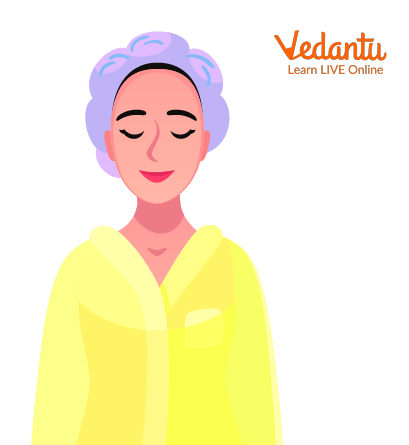
A Glowing Skin
What is the Integumentary System?
The skin has multiple layers (we will look into these shortly) and several related structures that help its effective functioning. All of these components can be collectively called the integumentary system.
Components of the integumentary system comprise:
Skin and its layers
Hair
Nails and
Exocrine glands (glands that secrete substances on the skin surface)
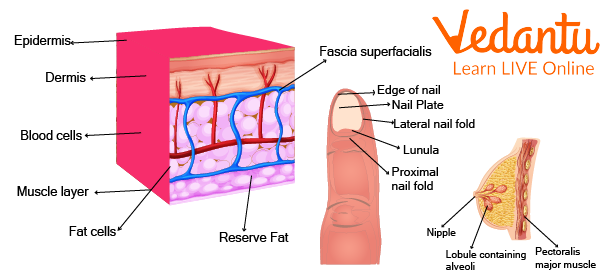
Skin
What is Skin?
Skin is the largest organ of our body protecting us from injuries through the external environment. They also keep the contents of the body in a well-organised manner.
Skin is primarily made up of water, proteins, fats, and important minerals.
On observing the skin under the microscope, you would notice square-shaped cells called epithelial cells arranged one on top of the other (known as stratified squamous epithelial cells). Hair follicles and glands open to this surface. Below you will find a detailed diagram.
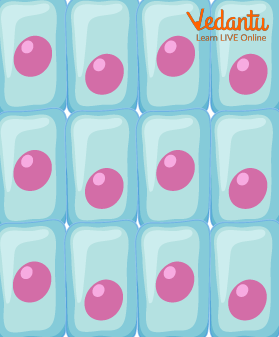
Epithelial Cells
Structure of the Skin
The skin has several layers inside out that help its function. Mostly it is divided into 3 layers:
Epidermis (‘Epi’ meaning above)
Dermis
Hypodermis (‘Hypo’ meaning below)
These layers are made of different cells and structures each performing its specific function.
Epidermis
The outermost layer of the skin is protective in function, act as first line of denfense again foreign antigens.
The epidermis has five layers -
Stratum corneum
Stratum lucidum
Stratum granulosum
Stratum spinosum
Stratum basale
It is made up of keratin which is a type of protein.
Cells of this layer are dry and get replaced by newer cells periodically.
Cells of the epidermis contain melanin (a special pigment) which gives us different skin tones.
They also contain various special types of cells that help their protective action.
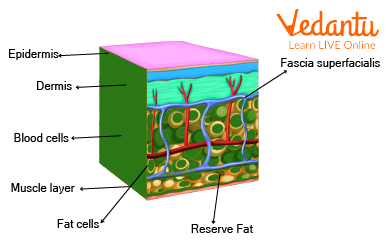
Epidermis of the Skin
Dermis
Cells of this layer contain elastin and collagen (again, various proteins) which help skin strength and flexibility.
This layer contains blood vessels that help the healthy functioning of the cells.
It contains specialised nerve endings which give it a ‘sense of touch
Sweat and oil glands are also present in this layer.
It contains roots of hair follicles thereby promoting hair growth.
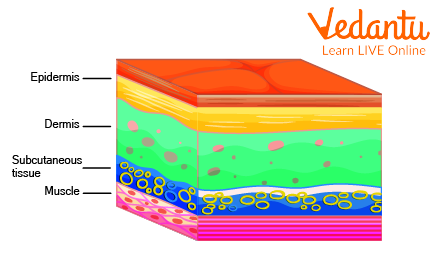
Crossectional View of the Dermis
Hypodermis
The deepest layer of skin connects skin to muscle tissues and bones.
It is a fatty layer providing a cushion effect to the contents of our body.
It helps connect nerves and blood vessels from the dermis to the main branches connecting the rest of the body.
It has specialised receptors (like a sensor) for extreme temperatures.
It acts as an insulation layer (protecting the body from extreme temperatures).
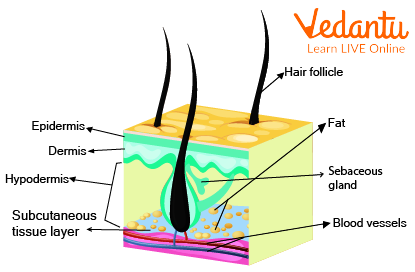
Structure of the Hypodermis
Specialised Structures Present in the Skin Layers
Hair follicles
Melanocytes (cells producing melanin pigment)
Sweat glands
Sebaceous glands (oil-producing glands)
Specialised protective cells prevent infections.
Functions of Skin
Provides us with a sense of touch.
Helps the body’s temperature regulation.
Storage of energy as a fat layer (subcutaneous fat present beneath the skin).
Protects us from harmful microbes around us.
Produces melanin which is important to protect from harmful UV radiation of the sun.
Protects us from cancer.
How to Maintain Good Skin Health?
Now that we’ve understood how important skin is for us, it is necessary to maintain this valuable organ and protect it from unnecessary damage. Some ways to maintain good skin health are :
Always use sunscreen.
Staying indoors to prevent too much tanning.
Consuming vegetables and fruits.
Drinking plenty of water.
Managing stress and getting proper sleep.

A Healthy Skin
Summary
The skin sense organ is one of the most important structures of the human body, known as the integumentary system. It comprises skin, hair, nails and the exocrine associated with it. Skin is made of very thin and elastic 7 layers often referred to as the 7 layers of skin. Some of the important layers are the epidermis, dermis and hypodermis. Functions of the skin include a sense of touch and temperature, protection against harmful radiations, and fat storage. It is important to consume green leafy vegetables, fruits, etc., to maintain the well-being of the overall integumentary system.
FAQs on What is Skin? Definition and Key Facts for Kids
1. What is skin and why is it important for our body?
Skin is the outer covering of our body and is actually our largest organ. It's incredibly important because it acts like a protective shield, covering our muscles, bones, and other organs to keep them safe from the outside world.
2. What are the main jobs of our skin?
The skin has several very important jobs to do for our body. Its main functions include:
- Protection: It acts as a barrier to keep out germs, dirt, and harmful rays from the sun.
- Sensation: It allows us to feel things like touch, pain, pressure, heat, and cold through tiny nerve endings.
- Temperature Control: It helps keep our body at the just-right temperature by sweating when we are hot and getting goosebumps when we are cold.
3. What are the different layers of the skin?
Our skin is made of three main layers, each with a special job. In simple terms for kids, they are:
- The Epidermis: This is the top, outer layer that you can see. It's tough and waterproof, protecting the layers underneath.
- The Dermis: This is the middle layer, found right below the epidermis. It contains nerve endings to feel things, sweat glands, and hair roots.
- The Hypodermis (Subcutaneous Fat): This is the bottom, fatty layer that helps keep us warm and cushions our body.
4. How does our skin help keep our body at the right temperature?
Our skin is like a smart thermostat. When we get too hot, tiny glands in our skin release sweat, which cools us down as it dries. When we are cold, the fat layer in our skin helps hold in heat. Our body might also start to shiver, which is when our muscles shake quickly to create warmth, and we get goosebumps.
5. Why do people have different skin colours?
People have different skin colours because of a special pigment called melanin, which is made in the epidermis. Melanin's job is to protect our skin from the sun's strong rays. The more melanin a person's skin makes, the darker their skin will be. The amount of melanin is determined by genetics passed down from our parents.
6. How does our skin help us feel things like touch and temperature?
The middle layer of our skin, the dermis, is filled with millions of tiny nerve endings. These nerve endings are like little messengers. When you touch something soft, hot, or sharp, they instantly send a signal to your brain, which then tells you what you are feeling.
7. Why do we get goosebumps when we feel cold or scared?
Goosebumps happen when tiny muscles at the base of each hair on our skin tighten, making the hair stand up. Long ago, this helped our ancestors stay warmer by trapping a layer of air close to the skin. It also made them look bigger to scare away predators. Even though we have less body hair now, our skin still reacts in the same way when we are cold or frightened.
8. What happens to our skin when we get a small cut?
When you get a small cut, your amazing skin starts to repair itself right away. First, the blood cleans the wound and then thickens to form a clot, which dries into a scab. This scab acts like a natural bandage, protecting the area from germs while new skin cells grow underneath. Once the new skin is ready, the scab falls off.
9. What are some simple ways for kids to take care of their skin?
Keeping your skin healthy is easy! You should wash your hands and body regularly with gentle soap and water to remove dirt and germs. It's also important to drink plenty of water, eat healthy foods, and protect your skin from the sun by wearing sunscreen or covering up when you play outside.









